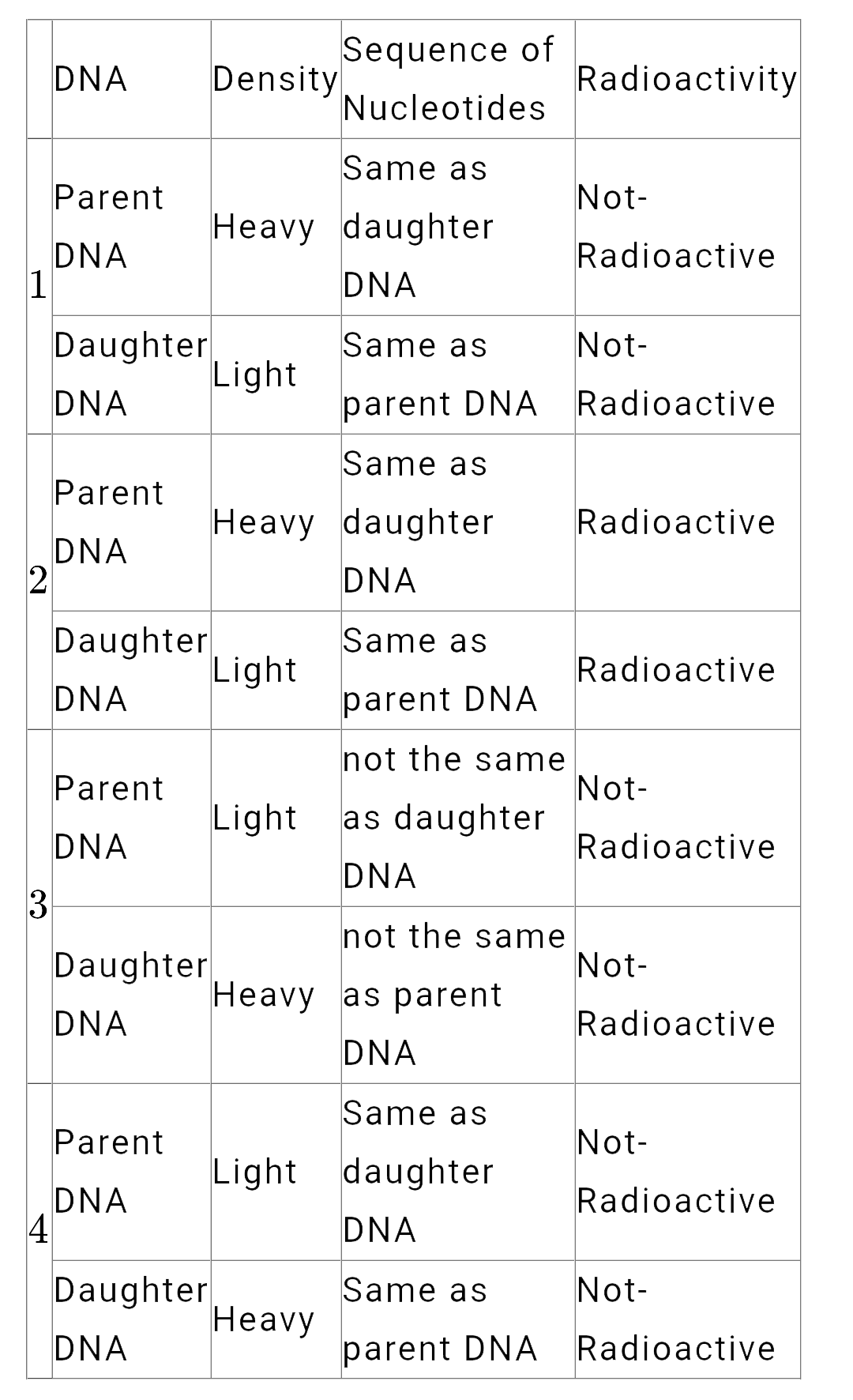E.coli has only 4.6 × 10 6 base pairs and completes the process of replication within 18 minutes, then the average rate of polymerisation is approximately
2000 base pairs/second
3000 base pairs/second
4000 base pairs/second
1000 base pairs/second
The correct Answer is:C
To find the average rate of polymerization of E. coli, we can follow these steps:
Step 1: Identify the total number of base pairs
E. coli has a total of 4.6 × 10^6 base pairs.
Step 2: Convert the time from minutes to seconds
The time taken for replication is given as 18 minutes. To convert this into seconds:
Time in seconds=18 minutes×60 seconds/minute=1080 seconds
Step 3: Calculate the average rate of polymerization
The average rate of polymerization can be calculated using the formula:
Rate of polymerization=Total base pairsTime in seconds
Substituting the values we have:
Rate of polymerization=4.6×106 base pairs1080 seconds
Step 4: Perform the division
Calculating the above expression:
Rate of polymerization≈4259.25 base pairs/second
Step 5: Round the result
Since we need to provide an approximate value, we can round this to:
Average rate of polymerization≈4000 base pairs/second
Final Answer
Thus, the average rate of polymerization for E. coli is approximately 4000 base pairs per second.
---
E. coli has a total of 4.6 × 10^6 base pairs.
The time taken for replication is given as 18 minutes. To convert this into seconds:
Time in seconds=18 minutes×60 seconds/minute=1080 seconds
The average rate of polymerization can be calculated using the formula:
Rate of polymerization=Total base pairsTime in seconds
Substituting the values we have:
Rate of polymerization=4.6×106 base pairs1080 seconds
Calculating the above expression:
Rate of polymerization≈4259.25 base pairs/second
Since we need to provide an approximate value, we can round this to:
Average rate of polymerization≈4000 base pairs/second
Thus, the average rate of polymerization for E. coli is approximately 4000 base pairs per second.
Topper's Solved these Questions
- PRINCIPLES OF INHERITANCE AND VARIATION BOOK - NEET PREVIOUS YEAR (YEARWISE + CHAPTERWISE)CHAPTER - PRINCIPLES OF INHERITANCE AND VARIATION EXERCISE - MCQ
161 Videos
- REPRODUCTION IN ORGANISMSBOOK - NEET PREVIOUS YEAR (YEARWISE + CHAPTERWISE)CHAPTER - REPRODUCTION IN ORGANISMSEXERCISE - Exercise
19 Videos
Similar Questions
If the distance between two consecutive base pairs is 0.34nm and the toal number of base pairs of a DNA double helix in a typical mammalian cell is 6,6×109bp, then the length of the DNA is approximately
View SolutionIn a reaction, the concentration of a reatant (A) changes from 0.200mol litre−1→0.150mol litre−1 in 10 minutes. What is the average rate of reaction during this interval ? N2O5→2NO2+1/2O2 the rate of disappearance of N2O5is6.5×10−3molL−1s−1. Computer the rates of formation of NO2andO2
View Solution
Knowledge Check
E.coli has only 4.6 × 10 6 base pairs and completes the process of replication within 18 minutes, then the average rate of polymerisation is approximately- (1) 2000 base pairs/second (2) 3000 base pairs/second (3) 4000 base pairs/second (4) 1000 base pairs/second
A3000 base pairs/secondB4000 base pairs/secondC1000 base pairs/secondD2000 base pairs/secondAssertion : E. coli divides in 20 minutes.
Reason : In E. coli the process of replication completes within 18 minutes.AIf both assertion and reason are true and the reason is the correct explanation of the assertion.BIf both assertion and reason are true but reason is not the correct explanation of the assertion.CIf assertion is true but reason is false.DIf both assertion and reason are false.The whole genome of Escherichia coli have _____ bp which is replication within_____ minutes6
A6.6x106,20B4.6x109,33C4.6x106,38D6.6x109,40
A dsDNA found in E. Coli has N15 labeled nitrogen bases. This organism was provided with N14 based nitrogen bases for the replication process . The two new DNA molecules synthesized after one round of replication in the N14 based medium . Which of the following options correctly describes the comparison between parent DNA and daughter DNA ?

View Solution5 milli-moles of a solid A was dissolved in 5 moles of H2O. On adding to the solvent, A starts polymerising into another insoluble solid following zero order kinetics. On adding 6 milli-moles of another solid solute C (after 20 minute) the polymerisation completely stops. The insoluble solid polymer is removed and the resulting solution was cooled to a temperature less then .−0.186∘C (freezing point of solution ) to cause solidification of some liquid water . Calculate the value of X if rate constant for polymerisation reaction is represented as 10−X moles/minute.
[Kf(H2O)=1.86K−Kgmole−1]
View SolutionAn inverted cone has a depth of 10cm and a base of radius 5cm. Water is poured into it at the rate of 3/2 c.c. per minute. Find the rate at which the level of water in the cone is rising when the depth is 4cm.
View SolutionIf the distance between two consecutive base pairs is 0.34nm and the toal number of base pairs of a DNA double helix in a typical mammalian cell is 6,6×109bp, then the length of the DNA is approximately
View SolutionA clock with only dots markirig 3, 6, 9 and 12 positions has been kept upside down in front of a mirror. In the reflection a time of 4.15 will look approximately like
View Solution
